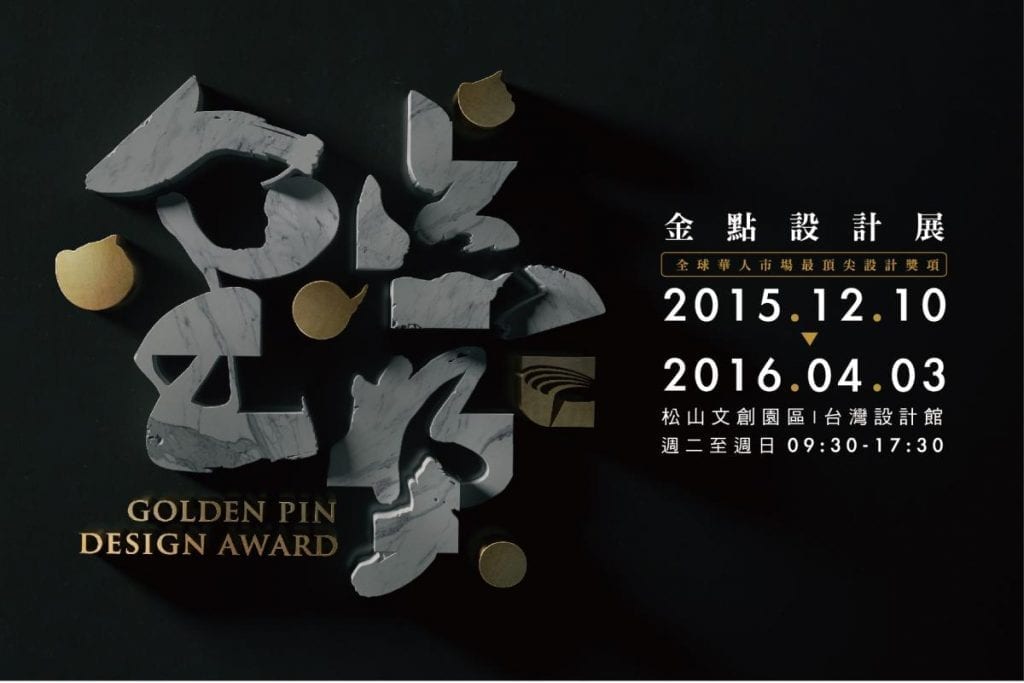
The Golden Pin Design Award–an annual award organized by the Taiwan Design Center that seeks to raise global awareness for design created for and within huaren (Chinese-speaking) communities–today reveals its Design Mark recipients for 2016.
After gruelling Secondary Selection judging rounds held in China and Taiwan, a total of 457 entries from Taiwan, China, Hong Kong, Macau, Malaysia, Singapore, Japan, and England, and Switzerland have received a Golden Pin Design Award 2016 Design Mark and are now in the running for a coveted Best Design trophy.
Contemporary ideas of refined living dominated entries from Hong Kong. For TUVE, a boutique hotel located east of Victoria Park, Design Systems Ltd used natural and relatively common materials such as concrete, galvanized steel, brass, oak, and wired glass to create a surprisingly sophisticated yet relaxing space for visitors. When homegrown jewelry brand Chow Tai Fook wanted to reach out to a younger market, Noiseless Design Limited drew inspiration from the card game poker to create a visual aesthetic that plays into the new generation’s mix-and-match approach to fashion.
Malaysian entries typically put a twist on what could be considered traditional huaren culture, such as in Dot Creative Design’s iPack, which added an element of play to the celebratory Chinese red envelope. Among entries from Macau was a plethora of thoughtfully designed posters for cultural events, including advertising by Untitled Lab for a tenth anniversary exhibition held by Centro De Estudos Permanentes Pos-Laboral and by Bilioteca Pública de Macau for the Macau Library Week 2016.
Among entries from China were a proliferation of unusual or highly specialized smart products for living, including Yourpet Smart Bowl by inDare Design Strategy Limited, which allows pet-parents to regulate their fur baby’s food intake via their smartphones, and Intelligent Frying Pan by Hangzhou Hotdesign Co. Ltd, which uses an app and bluetooth technology to teach users how to cook better, faster, and smarter. Ancient ideas about nature also featured heavily as design inspiration among visual communication products from the country. About Trees, an aptly named Chinese font design by Hanqingtang Design, was influenced by the rings and trunks of trees, and Book of Freedom by independent designer Sihan Chou references a story from Chinese mythology that documents the struggle of a fish adapting to the life of a bird.
It was clear that designers in Taiwan had thought carefully about the needs of those living in local or huaren communities: located in Taipei’s sublime Mandarin Oriental Hotel, restaurant Bencotto by Tony Chi & Associates embodies the best of contemporary huaren living; leading local homewares brand JIA Inc.’s Four Seasons Glass Set, designed by astute independent Taiwanese designer Pili Wu, portrays a glass bowl set as a Chinese ink painting for the table; new packaging for the nostalgically named soy sauce brand Grandpa Sauce incorporates traditional sisal rope to instil a sense of the past; and commuter bike Pick-Up Sliders adapts European practicality for life in bustling Taiwanese cities.
Groundbreaking concepts both large and small in scale abounded in the Spatial Design category. HEX-SYS by China-based firm OPEN Architecture is a reconfigurable and reusable building system that attempts to address the problems created by the country’s decades-old building frenzy. The Kaohsiung Public Library, a joint project by the Kaohsiung City Government and Ricky Liu & Associates Architects + Planners, is a public building designed to economize on resources without sacrificing access to necessary public amenities or the beatification of the neighborhood in which the building sits. At the other end of the scale, Formo Design Studio in Taiwan combines a laundrette with a sleek coffee shop, ensuring laundry doers can wile away the hours in style and comfort; the facility is aptly named Travelled 9000 km.
Overall, the 2016 entries into the Golden Pin Design Award received high praise from Secondary Selection judges. “You can really see the efforts of participants, as this year’s entries demonstrated an understanding of the importance of finding the balance between the market and huaren cultural values. In particular, spatial design entries have greatly improved, showing a balance between huaren culture elements and mainstream spatial aesthetics,” noted Shikuan Chen, Compal design director, educator, Icsid board member, and Jury Chair of the Secondary Selection judging round in Taipei.
The Golden Pin Design Award–Taiwan’s longest-running and most prestigious design award–opened its doors to entries from and for huaren (Chinese-speaking) communities around the globe in 2014. This year sees a 27% growth in number of entries submitted into the Golden Pin Design Award: in 2015, the award received 2,360 entries compared with this year’s record-breaking 3,005 entries. Final Selection–the jury of which will be chaired by world-leading Japanese-Canadian designer Oki Sato, Chief Designer and founder of the famed Tokyo-based studio Nendo–will held in Taipei on September 28, with Best Design of the Year recipients announced on December 1 at a grand award ceremony, also held in Taiwan’s capital city.

